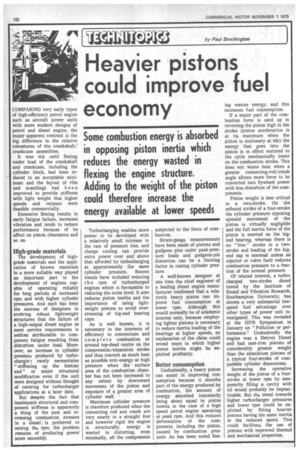Heavier pistons could improve fuel economy
Page 124

If you've noticed an error in this article please click here to report it so we can fix it.
Some combustion energy is absorbed in opposing piston inertia which reduces the energy wasted in flexing the engine structure.
Adding to the weight of the piston could therefore increase the energy available at lower speeds
COMPARING very early 'types of high-efficiency petrol engine such as aircraft power units with more modern designs of petrol and diesel engine, the major apparent contrast is the big difference in the relative robustness of the crankshaft/ crankcase assemblies.
It was not until flexing under load of the crankshaft and crankcase, including the cylinder block, had been reduced to an acceptable minimum and the ;layout of ribs and scantlings had been improved to provide stiffness with light weight that higher speeds and outputs were feasible commercially.
Excessive flexing results in early fatigue failure, increases vibration and tends to reduce performance because of its affect on piston clearances and so on.
High-grade materials
The development of highgrade materials and the application of known materials in a more suitable way played an important part in the development of engines capable of operating reliably for long periods at increased rpm and with higher cylinder pressures. And such has been the success of -designers in evolving robust lightweight Structures that the failure of a high-output diesel engine to meet service requirements is seldom attributable to component fatigue resulting from distortion under load. Moreover, an increase in cylinder pressure produced by turbochargin7 rarely necessitates "stiffening up the bottom end" or major structural modification even if the unit were designed without thought of catering for turbocharger applications at a later date.
But despite the fact that inadequate structural and component stiffness is apparently a thing of the past and increasing combustion stresses in a diesel:: is preferred to raising the rpm, the problem remains of producing power more smoothly. Turbocharging enables more power to be developed with a relatively small increase in the rate of pressure rise, and charge cooling can provide extra power over and above that afforded by turbocharging at approximately the same cylinder pressure. Recent trends have ineluded reducing t h e rpm of turbocharged engines which is favourable to reducing the noise level. It also reduces piston inertia and the importance of using lightweight pistons to avoid overstressing of big-end bearing caps.
As is well known, it is necessary in the interests of efficiency to concentrate and co mpl et e combustion at around top-dead centre on the compression/expansion stroke and thus convert as much heat as possible into energy at high pressure when the surface area of the combustion chamber has not been increased to any extent by downward movement of the piston and exposure of a greater area of cylinder wall. • Maximum cylinder pressure is therefore produced when the connecting rod and crank are very nearly in a straight line and however rigid the engine is structurally, energy is wasted in distorting, even minimally, all •the components subjected to the force of combustion.
Strain-gauge measurements have been made of pistons and gudgeon pins under peak-pressure loads and gudgeon-pin distortion can be a limiting factor in raising cylinder pressure.
A well-known designer at one time the chief engineer of a leading diesel engine manufacturer confirmed that a relatively heavy piston can improve fuel consumption at lower rpm. Although this would normally be of academic interest only, because employing lighter pistons is necessary to reduce inertia loading of the bearings at higher speeds, an explanation of the claim could reveal ways in which higher piston inertia might be exploited profitably.
Better consumption
Undoubtedly, a heavy piston can assist in improving consumption because it absorbs part of the energy produced by combustion, the amount of energy absorbed transiently being about equal to piston inertia in the case of a high speed petrol engine operating at peak rpm. And this reduces deformation of the components, including •the piston, caused by combustion pressure. As has been noted flex ing wastes energy; and this increases fuel consumption.
If a major part of the combustion force is used up in reversing the piston high in the stroke (piston acceleration is at its maximum when the piston is stationary at tdc) the energy that goes into the piston is in effect restored to the cycle mechanically lower on the combustion stroke. This does not waste heat when a greater connecting-rod/crank angle allows more force to be converted into flywheel power with less distortion of the components.
Piston weight is less critical in a two-stroke. On the exhaust stroke of a four-stroke the cylinder pressure opposing upward movement of the piston is virtually negligible and the full inertia force of the piston is exerted on the bigend bearing, whereas there is no "free " stroke in a twostroke and loading of the bigend cap is nctininal unless an injector or valve fault reduces combustion pressure to a fraction of the normal pressure.
Of related interest, a turbocharged two-stroke diesel tested by the Institute of Sound and Vibration Research, Southampton University, has shown a very substantial lowspeed fuel advantage over other types of power unit investigated. This was revealed at the ISVR Symposium in January on "Pollution or performance." Undoubtedly the engine was a Detroit Diesel and had cast-iron pistons of considerably greater weight than the aluminium pistons of a typical four-stroke of comparable cylinder dimensions.
Increasing the operative weight of the piston of a fourstroke at lower rpm by temporarily filling a cavity with oil would probably be impracticable. But the trend towards higher turbocharger pressures and lower rpm could be exploited by fitting heavier pistons having the same inertia at the reduced speed. This could facilitate the use of pistons with improved thermal and mechanical properties.
















































































































































































































